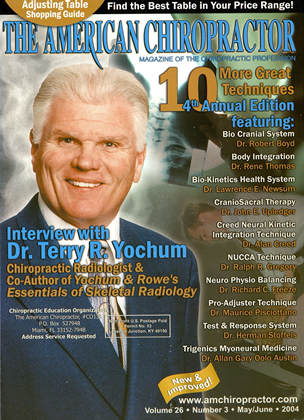N i:\V PATIENTS TYPICALLY COME IN to your office with many unanswered questions. They are somewhat apprehensive and are just looking for solutions to their problems. Most will have a very limited, if any, understanding of chiropractic care. They have entered a new world and are not quite sure what they will find, but they are open-minded enough to give it a try. They have walked through your door and now you have the opportunity to educate each one regard- ing chiropractic care and, specifically, what you have to offer them. In the course of conducting your Report of Findings, several questions will arise. How you choose to answer these questions may make the difference between retaining your patient or losing your patient. 1. How long is it going to take? Before patients even begin to receive '-treatment, they want to know when they -will be finished! Of course, it is impossible to accurately answer this question prior to conducting an analysis, putting the person on a treatment plan and monitoring their rate of response. An individual's rate of response is how quickly they respond to the treatment being administered. While the rate of response can usually be determined after 3-4 visits, it is specific to the individual and their personal condition. (Use your past experience to help.) You need to explain this information so your patient understands what is necessary prior to your giving them an end date for their treatment. Providing information in this manner lays the foundation on which additional education can be shared. Your patient should have a relatively accurate prediction from you regarding their case within the first few days. 2. How often do I have to come? Be honest regarding your expectations of them as a patient. Consistent treatment is the key to their health and wellness. If they need an intensive treatment schedule of three times a week, tell them. Ask them if they are going to be able to commit to such a schedule for the benefit of their health. Never give ranges such as 2-3 times per week. If you do this, your patient will only hear the lower number and this will hinder their care plan. They need to understand what it is going to take for them to reach corrective care through chiropractic. Now is an ideal time to discuss the difference between relief care and corrective care. Remember, an educated patient is a compliant patient who will also refer you more patients. 3. Does it hurt? The answer to this question is directly tied to the technique you utilize in your practice. Your chiropractic philosophy and methods of treating patients need to be explained to your patient. Clearly define and describe your technique(s) and any physical discomforts that may accom- pany your treatment. With the advancement of technology in the chiropractic field, many doctors can easily respond that there is no pain or discomfort with their treatment. Educate your patient on any computerized instrumentation, testing procedures or rehabilitation equipment that may be a part of their treatment plan. Provide a consistent explanation to all your patients detailing any technology or methodology that you use. 4. What is it going to cost? Since you are not sure how long their entire treatment is going to take, you will not know the exact cost of their treatment. However, you can- not avoid answering this question. Confusion over -^^^^ finances will prevent continuation of care. Giving an individual an understanding of the cost will allow you to continue care and further educate your patient. As a practicing chiropractor, you are in a position to give a range of cost based on other patients with similar conditions and treatment plans. Explain this to your patient. Take the time to discuss any insurance issues and clearly define their financial responsibilities for their treatment. Answering these four major questions with your patient will lead to a smooth and productive relationship right from the start. They understand what to expect from you and chiropractic, and know what you expect from them as a patient. Education and understanding lead to healthy chiropractic patients on maintenance care! I Dr. Maurice A. Pisciottano. CEO and founder of Pro-Solutions for Chiropractic, is a practicing chiropractor, noted lecturer, author, producer and research and development technologist. He is well known for his practice management expertise, as well as new patient development programs. He has devoted the past twelve years to the development of the instrumentation and the computerization of chiropractic treatment and documentation. Dr. Pisciottano regularly lectures at Palmer College of Chiropractic in Davenport, 1A. and at Logan College of Chiropractic in St. Louis. MO. He can be reached at Pro-Solutions for Chiropractic in Pittsburgh. PA. at 1-877-942-4284.
 View Full Issue
View Full Issue






